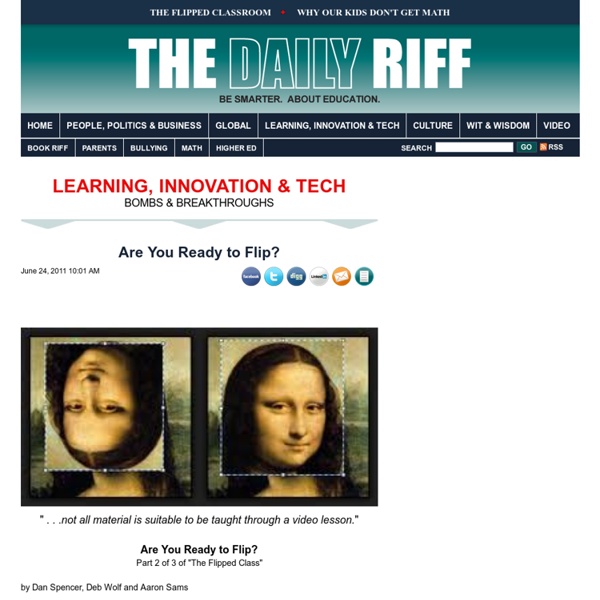The Flipped Class Revealed
Editor's Note: This is Part 3 of 3 of The Flipped Class Series at The Daily Riff. You can start here, by reading this post, and go backwards and still understand what's going on in the conversation. Links to Part 1, "The Flipped Class: What it Is and What it is Not," and Part 2 - "Are You Ready to Flip? The Flipped Class What Does a Good One Look Like? "The classroom environment and learning culture play a large role in determining the best pedagogical strategy." by Brian Bennett, Jason Kern, April Gudenrath and Philip McIntosh The idea of the flipped class started with lecture and direct instruction being done at home via video and/or audio, and what was once considered homework is done in class. Now, it is becoming much more than that. The main reason, maybe the only reason, to flip a class is to provide more class time for learning and that is the major shift that we are seeing as the flip gains popularity across content areas. Originally published by The Daily Riff June 23, 2011
Creating E-learning for Teachers – Part 1
If you are a technology leader who teaches technology to teachers, consider moving more towards e-learning. I touched upon this in my post, Your School Needs and LMS. Let’s look at some ways to create e-learning lessons for your faculty. We’ll get to some of my favorite tools shortly. “I keep getting calls to reset forgotten passwords for the school website. You get the idea. Quick E-learning Tools If you need a quick screencast try Screenr.com. Jing is similar to Screenr except it is a client-based application. If you are getting serious about creating e-learning lessons for your teachers, you need to move to professional products. Need more power? About Mark Mark Brumley is an educational technology leader, presenter and professional development facilitator who has lived and worked around the globe in his commitment to provide authentic learning experiences to enhance the education of 21st Century learners.
FlippedLearning - EduVision
The Flipped Class: Myths vs. Reality
Editor's Note: On the heels of our viral posts in over 100 countries about the flipped classroom earlier this year (links below), we asked Jon Bergmann if he could share some of the feedback he was receiving in light of the notable interest about this topic. The timing couldn't have been more perfect since he was about to leave for a conference about you-guessed-it, the flipped class. Here is Part 1 of our three part series The Daily Riff. See Part 2 and 3 links below. - C.J. Westerberg The Flipped Class: What it is and What it is Not by Jon Bergmann, Jerry Overmyer and Brett Wilie There has been a lot of interest in the flipped classroom. The traditional definition of a flipped class is: The Flipped Classroom is NOT: A synonym for online videos. Originally published The Daily Riff July 2011 Jon Bergmann is one of the first teachers to flip his classroom and has recently co-authored a book on the the Flipped Class which is to be published by ISTE press. Video Montage from Conference Below
How To Create Your Own Social Media Network With Ning - Robin Good's Latest News
learning4mastery
Educating Educators, Part 1
Technology training sessions are surely in your near future. August is when teachers return and school implement new technology tools and procedures. How do your successfully educate your educators? Generate Excitement Before any training begins, you must hype the new technology. In a classroom, a good teacher begins a unit with an anticipatory set. You have to have some sort of PR campaign to tout the benefits of the new technology. Tip: You know the cheesy commercial s showing cheap kitchen appliances? Time is ticking! About Mark Mark Brumley is an educational technology leader, presenter and professional development facilitator who has lived and worked around the globe in his commitment to provide authentic learning experiences to enhance the education of 21st Century learners.
Cycles of Learning
The Flipped Classroom Model: A Full Picture
Due to Khan Academy’s popularity, the idea of the flipped classroom has gained press and credibility within education circles. Briefly, the Flipped Classroom as described by Jonathan Martin is: Flip your instruction so that students watch and listen to your lectures… for homework, and then use your precious class-time for what previously, often, was done in homework: tackling difficult problems, working in groups, researching, collaborating, crafting and creating. A compiled resource page of the Flipped Classroom (with videos and links) can be found at The advantage of the flipped classroom is that the content, often the theoretical/lecture-based component of the lesson, becomes more easily accessed and controlled by the learner. It is important, though, not to be seduced by the messenger. The problem is that educators, as a group, know how to do and use the lecture. The Flipped Classroom Model Experiential Engagement: The Activity Summary
Online Social Networking for Educators
By Cindy Long By now, you’ve heard the buzz about MySpace and Facebook, but you may still be wondering what all the fuss is about. Maybe you’re a little mystified by the whole social networking craze, or you’re a little wary about venturing into your students’ territory. Sure, some of you are skeptical, and with good reason. “There are lots of negative connotations surrounding social networking,” says Steve Hargadon, an educational technology expert and founder of Classroom 2.0, a popular social network for teachers. Coined by Australian professor J.A. On the Web, groups of like-minded people have formed networks around everything from language, religion, and geography to health condition, hobbies, or even arcane academic disciplines. Dubbels is a member of what he calls “the big three”—the ubiquitous MySpace and Facebook, as well as LinkedIn, a hugely popular business-oriented social networking site where Dubbels wears his teacher hat. The AppleWhere teachers meet and learn.



